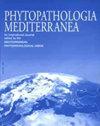Genotype variation of citrus tristeza virus after passage on different hosts, and changes in the virus genotype populations by the vector Aphis gossypii
IF 1.9
3区 农林科学
Q2 AGRONOMY
引用次数: 1
Abstract
Phylogenetic analyses categorize seven genotypes of citrus tristeza virus (CTV). The symptoms caused by this pathogen, their expression and severity are influenced by CTV genotypes, host species, cultivars, and infected host rootstocks. This study aimed to verify how populations of Chilean CTV isolates changed following inoculation from infected sweet orange to Mexican lime trees, and to determine if CTV genotype populations influenced transmission efficiency via Aphis gossypii. Reverse transcription polymerase chain reaction showed variation in genotypes of populations of CTV in Mexican lime, after graft inoculations using infected sweet orange chip-buds. Severe genotypes (VT) were detected after inoculation of mild isolate CTV populations (T30). The T30 donor populations also reduced transmissibility via A. gossypii; however, these results may not be conclusive due to mixture with the VT genotype. There is evidence of high rates of virus acquisition by this aphid species, but also low transmission efficiency, which may partially explain the historical absence of tristeza epidemics in Chile.柑桔三体病毒在不同寄主上传代后的基因型变异及棉蚜对病毒基因型群体的影响
系统发育分析对柑桔三体病毒(CTV)的7种基因型进行了分类。这种病原体引起的症状、它们的表达和严重程度受到CTV基因型、宿主物种、品种和受感染的宿主砧木的影响。本研究旨在验证智利CTV分离株在从受感染的甜橙到墨西哥酸橙树接种后的种群变化,并确定CTV基因型种群是否影响棉蚜的传播效率。逆转录聚合酶链式反应显示,使用受感染的甜橙切片芽进行移植接种后,墨西哥酸橙中CTV群体的基因型发生了变化。接种轻度分离CTV群体(T30)后检测到严重基因型(VT)。T30供体群体也降低了棉蚜的传播性;然而,由于与VT基因型的混合,这些结果可能不是决定性的。有证据表明,这种蚜虫的病毒获取率很高,但传播效率也很低,这可能部分解释了智利历史上没有三叶蜂流行的原因。
本文章由计算机程序翻译,如有差异,请以英文原文为准。
求助全文
约1分钟内获得全文
求助全文
来源期刊

Phytopathologia Mediterranea
生物-植物科学
CiteScore
4.40
自引率
8.30%
发文量
28
审稿时长
6-12 weeks
期刊介绍:
Phytopathologia Mediterranea is an international journal edited by the Mediterranean Phytopathological Union. The journal’s mission is the promotion of plant health for Mediterranean crops, climate and regions, safe food production, and the transfer of new knowledge on plant diseases and their sustainable management.
The journal deals with all areas of plant pathology, including etiology, epidemiology, disease control, biochemical and physiological aspects, and utilization of molecular technologies. All types of plant pathogens are covered, including fungi, oomycetes, nematodes, protozoa, bacteria, phytoplasmas, viruses, and viroids. The journal also gives a special attention to research on mycotoxins, biological and integrated management of plant diseases, and the use of natural substances in disease and weed control. The journal focuses on pathology of Mediterranean crops grown throughout the world.
The Editorial Board of Phytopathologia Mediterranea has recently been reorganised, under two Editors-in-Chief and with an increased number of editors.
 求助内容:
求助内容: 应助结果提醒方式:
应助结果提醒方式:


